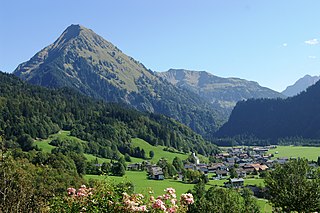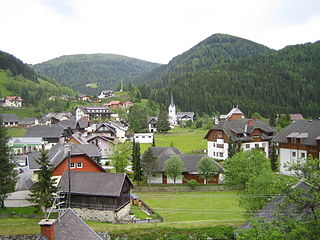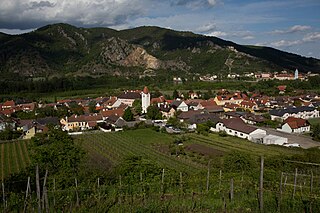
Au is a town in the Bregenz Forest in Vorarlberg (Austria).

Mellau is a town in the Bregenz Forest in the westernmost Austrian state of Vorarlberg, part of the district of Bregenz.

Krumbach is a market town in southern Lower Austria, Austria. It is part of the landscape Bucklige Welt.

Hainburg an der Donau is a town located in the Bruck an der Leitha district in the state of Lower Austria of eastern Austria. In 2021 it had a population of about 7,000.
Rohr im Gebirge is a village in the Wiener Neustadt-Land district of Lower Austria in Austria.

Theresienfeld is a town in the Wiener Neustadt-Land district of Lower Austria, in eastern Austria. It lies 5 km (3 miles) north of Wiener Neustadt, in the southern part of the Vienna Basin. Of its 11.47 km2 area, 3.40% is forested.

Waidmannsfeld is a municipality in the Wiener Neustadt-Land District, Lower Austria, Austria. The forested portion of the municipality amounts to 77.9% of its area. Waidmannsfeld consists of the cadastral communities Neusiedl and Waidmannsfeld.

Schoppernau is a town in the Bregenzerwald Region of the Austrian state of Vorarlberg. Schoppernau has an area of 47.64 km2.

Murfeld was the southernmost municipality of the Austrian district of Südoststeiermark. As of January 1, 2020, the Municipality was split between the Municipalities of Sankt Veit am Vogau and Straß in Steiermark, to the east, in the district of Leibnitz. The Catastral Subdivision of Seibersdorf bei Sankt Veit (289) merged with Sankt Veit am Vogau. The Catastral Subdivisions of Lichendorf (494), Oberschwarza (152), Unterschwarza (213) and Weitersfeld (527) merged with Straß in Steiermark.

Pama is a town in the district of Neusiedl am See in the Austrian state of Burgenland.

Reichenau is a municipality in the district of Feldkirchen in the Austrian state of Carinthia.

Heiligenkreuz is a municipality in the district of Baden, in the Austrian state of Lower Austria. It is known for the Cistercian monastery of Heiligenkreuz Abbey, the associated papal college Benedict XVI, commonly known as Hochschule Heiligenkreuz, and the Catholic Leopoldinum seminary.

Hauskirchen is a town in the district of Gänserndorf in the Austrian state of Lower Austria.

Rossatz-Arnsdorf is a town in the district of Krems-Land in the Austrian state of Lower Austria. It is located in the Wachau valley of the Danube, a popular destination for tourists, and has excellent views of the ruins of castle Dürnstein, where King Richard the Lion-Heart of England was held captive by Duke Leopold V.

Gießhübl is a town in the district of Mödling in the Austrian state of Lower Austria. It is located in the south of Vienna, the Austrian capital, neighboring the nature protection area Föhrenberge. With an altitude of 416 m, Gießhübl is the highest-located wine-growing district in Lower Austria. Originally Gießhübl was an agrarian village. Today it is mainly a residential area because of its vicinity to Vienna and the direct connection to the highway A21.

Birgitz is a community in the district of Innsbruck in Tyrol and lies on a terrace of the highlands 10 km south west of the capital. The nearest neighbouring village is Axams in the west and Götzens in the east.

Prutz is a municipality in the Landeck district in the Austrian state of Tyrol. Located at the mouth of the Kauner valley on the upper Inn, it is 10 km south of the city of Landeck and 36 km north of Reschen Pass, that forms the border to Italy. The border to Switzerland is located 23 km away towards the south-west.

Sautens is a municipality in the Imst district located 9 kilometres (6 mi) southeast of Imst on the lower course of the Ötztaler Ache. The village is located to catch the sun but is protected from the wind, which makes for an especially mild climate. The main source of income is agriculture. Fruit is especially important with a good part of the harvest used to make Schnapps.

Langenegg is a municipality with approx. 1,200 inhabitants in the westernmost Austrian state, Vorarlberg.

Pischelsdorf am Kulm is since 2015 a municipality in Weiz District in Styria, Austria. The area of the town covers 28.14 square kilometres (10.86 sq mi). In the Styria municipal structural reform, the new town was formed by merging Pischelsdorf in der Steiermark with the smaller villages of Reichendorf and Kulm bei Weiz, to reduce costs and ease election of town officials.





















